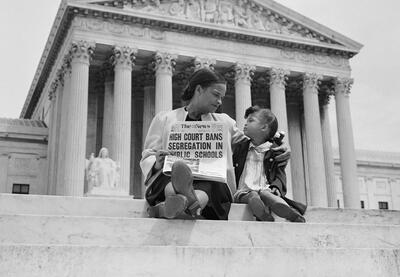Our goal is not simply to learn about the Civil Rights Movement but to learn from the movement. This learning journey examines the questions: How did people organize, and what strategies did they use in the movement for equality and justice?
Movement leaders and organizers combined legal, legislative and activist strategies in the late 1940s and 1950s for achieving political and social equality, which advanced the Civil Rights Movement of the 1960s.
- The movement for racial equality drew on a wide variety of tactics for securing civil rights, including legal challenges to segregation, community organizing and direct action. Southern Black communities were at the center of the political challenge of the movement.
- Using direct action, local groups organized boycotts and protests. One of the most famous of these was the Montgomery Bus Boycott. This yearlong protest, beginning in December 1955 and organized by a broad coalition, ultimately played a role in a Supreme Court decision mandating the desegregation of city buses.
- The legal strategy of the National Association for the Advancement of Colored People (NAACP) culminated in a series of Supreme Court rulings that expanded rights for African Americans across the country, including rulings desegregating buses and successful challenges to laws that segregated schools and restricted voting.
- The most famous legal victory of this era was the 1954 Supreme Court case Brown v. Board of Education of Topeka, in which the Supreme Court ordered the desegregation of public schools, striking down the “separate but equal” doctrine established by Plessy v. Ferguson.
Research and Learn More
- To consider emerging differences about tactics and strategies within the movement, learn about the National Association for the Advancement of Colored People (NAACP) and its work challenging racial segregation in the courts. The Library of Congress offers a helpful overview of the organization’s work during and directly after WWII in the online exhibit NAACP: A Century in the Fight for Freedom.
- Compare the NAACP’s emphasis, under Walter White’s leadership, on legal challenges to segregation with the work of the Congress of Racial Equality (CORE), which promoted direct action under the early leadership of James Farmer and Bayard Rustin. To learn more about CORE, review the online resources available through the SNCC Digital Gateway page Congress of Racial Equality (CORE), which includes an overview and links to several primary source documents.
- The SNCC Digital Gateway archive offers a short biography and several primary source resources to help you understand how activist Ella Baker’s work pushed the NAACP to focus on overall membership and the growth of Southern branches, paving the way for more direct action in the South.
- While the Montgomery Bus Boycott thrust Martin Luther King Jr. onto a national stage, it was also the work of a coalition of activists. Black women played key roles in organizing some of the most famous protests of the Civil Rights Movement of the 1950s and 1960s, including the Montgomery Bus Boycott. To better understand this history, review the 1954 “Letter Written From Jo Ann Robinson to Mayor W.A. Gayle,” in which the Montgomery Women’s Political Council president threatened the mayor with a bus boycott if African American riders did not receive fair treatment. And you can also read the NPR story “Before Rosa Parks, There Was Claudette Colvin” to learn more about the 15-year-old girl who refused to vacate her seat nine months before the boycott.
- To examine the planning that led up to Brown v. Board of Education, review the National Archives resource Timeline of Events Leading to the Brown v. Board of Education Decision of 1954. You can also review the Brown Foundation’s page Combined Brown Cases, 1951-54, which summarizes the five court cases the NAACP filed around the country as part of their legal strategy against segregation that were all combined by the court in Brown.
- You can also review some of the oral histories collected by the Lowcountry Digital History Initiative in Somebody Had To Do It: First Children in School Desegregation. Time magazine’s 2017 article “‘I Had a Right To Be at Central’: Remembering Little Rock’s Integration Battle” includes a video and reflections from Carlotta Walls, who at 14 was one of the first students to integrate Central High School in Little Rock, Arkansas.
A Conversation With Charles Person
Watch this video interview with Charles Person, the youngest of the original 1961 Freedom Riders, and think about the strategies Mr. Person describes in his experiences during the Civil Rights Movement.
Reflection and Action
1. Envision a Multiracial, Inclusive Democracy
To achieve positive change, we need to imagine the world we want to build (and not just the injustices we oppose). What would a multiracial, inclusive democracy look like in your community?
For Youth Learning for Justice: Be creative – use words or art or music – in describing the changes and community that you envision for a true multiracial and inclusive society.
2. Illustrate the Movement’s Strategies
The Civil Rights Movement used a wide variety of strategies. Consider how you would explain or teach someone about the main strategies (legal challenges, community organizing and direction action) used during the Civil Rights Movement.
For Youth Learning for Justice or collaborative learning: Create a graphic organizer – or illustration and include examples of each strategy.
3. Action in Your Community
Find out about community groups and organizations in your state that are advocating for equality and justice. What are they doing, and what strategies are they using? Are there opportunities for you join in their work?
